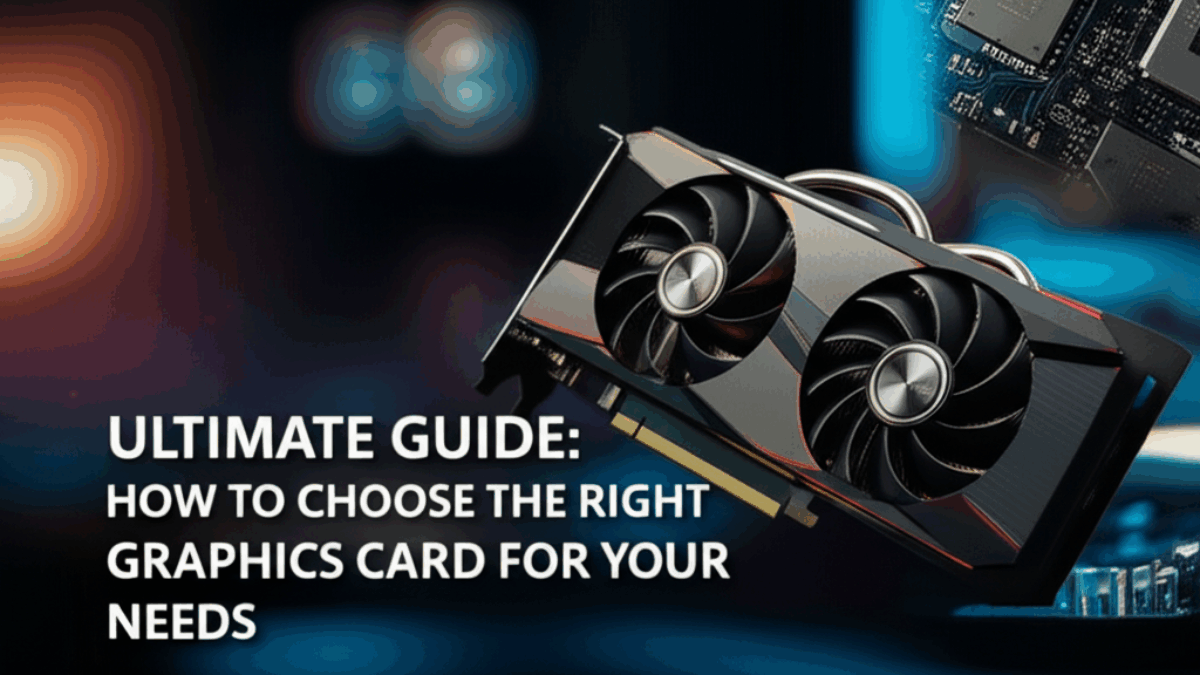In the age of digital experiences, where visuals play a pivotal role in our daily lives, graphics cards have emerged as one of the most sought-after components in personal computers. Whether you’re a gamer, a student, a professional designer, or simply someone who enjoys high-quality media, selecting the right graphics card can greatly influence your productivity and enjoyment. With new releases and ever-evolving technology, there’s no shortage of options, making it crucial to understand what you need. In this ultimate guide, we’ll break down everything you need to know about choosing the right graphics card—from key features to detailed comparisons and tailored recommendations.
Why Graphics Cards Are Trending
As we dive deeper into a visually driven world—be it through gaming, video editing, virtual reality, or even artificial intelligence applications—the demand for high-performance graphics cards continues to soar. Recent trends have only exacerbated this need:
-
Gaming Explosion: With the rise of AAA games boasting stunning graphics, gamers seek powerful GPUs to enhance their experiences.
-
Remote Work and Learning: With more people working and studying from home, professionals require robust hardware for design software, video editing, and data visualization.
-
Emergence of Creators: Content creation platforms, such as YouTube and Twitch, have seen a surge in users needing capable graphics cards for live streaming and video rendering.
-
Cryptocurrency Mining: Although its popularity has fluctuated, the demand for GPUs has often surged due to cryptocurrency mining, affecting availability and pricing.
- AI and Machine Learning: As AI technologies evolve, researchers and developers seek powerful GPUs to handle intensive computing tasks.
Key Features to Look For
Choosing the right graphics card requires understanding the crucial specifications that align with your needs. Below are key features to consider:
1. GPU Architecture
- Definition: The GPU architecture determines how the graphics processing unit operates.
- Relevance: Different architectures optimize performance for various tasks. For instance, NVIDIA’s Ampere architecture offers superior performance in ray tracing and AI, while AMD’s RDNA 2 excels in gaming efficiency.
2. VRAM (Video RAM)
- Definition: VRAM is dedicated memory used by the GPU to store textures, images, and videos.
- Recommendation: For general use, 4GB is adequate; 6GB is ideal for gaming; and 8GB or more suits professionals working with high-resolution textures or video editing.
3. Clock Speed
- Definition: The clock speed measures how quickly a GPU can process data, often discussed in MHz or GHz.
- Importance: Higher clock speeds translate to faster performance, making it particularly critical for gaming and rendering tasks.
4. CUDA Cores/Stream Processors
- Definition: CUDA cores (NVIDIA) and Stream Processors (AMD) are the GPU’s parallel processing units.
- Importance: More cores generally mean better performance, especially in tasks that can utilize parallel computing, like 3D rendering and complex simulations.
5. Power Consumption and Thermal Design
- TDP (Thermal Design Power): Indicates the maximum heat the cooling system must dissipate.
- Recommendation: Ensure your power supply can handle the GPU’s power demands plus additional components, and consider systems with efficient cooling solutions to maintain performance without overheating.
6. Ports and Connectivity
- Essential Interfaces: HDMI, DisplayPort, and, for older setups, DVI.
- Relevance: The number and type of ports dictate the resolution and refresh rates you can utilize. Ensure compatibility with your monitor(s).
7. Ray Tracing and DLSS
- Ray Tracing: A rendering technique for realistic light and shadow effects.
- DLSS (Deep Learning Super Sampling): NVIDIA’s technology leverages AI to upscale lower resolutions to improve performance without sacrificing quality.
8. Budget and Future-Proofing
- Budget Considerations: Determine how much you’re willing to spend while also considering future-proofing—opting for a card that meets not just your current needs but will sustain efficacy over the next few years.
Comparison of Top Products in the Market
To better guide your decision, let’s compare some popular graphics cards currently available, discussing their pros and cons.
1. NVIDIA GeForce RTX 3080
-
Specifications:
- VRAM: 10GB GDDR6X
- CUDA Cores: 8704
- TDP: 320W
-
Pros:
- Exceptional gaming performance.
- Ray tracing and AI capabilities.
- Good future-proofing for upcoming titles.
- Cons:
- High power consumption; requires a robust power supply.
- Can be expensive, depending on availability.
2. AMD Radeon RX 6800 XT
-
Specifications:
- VRAM: 16GB GDDR6
- Stream Processors: 4608
- TDP: 300W
-
Pros:
- Strong performance in 1440p gaming.
- More VRAM for workloads involving textures.
- Competitive pricing against similar NVIDIA cards.
- Cons:
- Limited ray tracing features compared to NVIDIA.
- Availability can be an issue.
3. NVIDIA GeForce GTX 1660 Super
-
Specifications:
- VRAM: 6GB GDDR6
- CUDA Cores: 1408
- TDP: 125W
-
Pros:
- Affordable price point for budget gamers.
- Efficient power consumption.
- Great for 1080p gaming.
- Cons:
- Lacks ray tracing capabilities.
- Limited future-proofing as games demand more power.
4. AMD Radeon RX 5700 XT
-
Specifications:
- VRAM: 8GB GDDR6
- Stream Processors: 2560
- TDP: 225W
-
Pros:
- Strong 1440p performance.
- Competitive pricing against NVIDIA options at launch.
- Cons:
- Limited ray tracing capabilities.
- Cooling can be less effective depending on the model.
Use-Case Scenarios
1. Students and Casual Users
- Best Choice: NVIDIA GeForce GTX 1660 Super or AMD Radeon RX 5500 XT.
- Why: Designed for everyday tasks like streaming, browsing, and light gaming, these cards are cost-effective while providing solid performance.
2. Professional Designers and Creators
- Best Choice: NVIDIA GeForce RTX 3080 or AMD Radeon RX 6800 XT.
- Why: These cards are tailored for intensive tasks like 3D modeling, video editing, and rendering, providing the power and features needed for professional-grade work.
3. Gamers
- Best Choice: NVIDIA GeForce RTX 3080 or AMD Radeon RX 6800 XT.
- Why: Both cards handle modern games at high settings and resolutions, offering excellent performance, including ray tracing features.
4. Tech Enthusiasts and Future-Proofing
- Best Choice: NVIDIA GeForce RTX 3090 or AMD Radeon RX 6900 XT.
- Why: If budget allows, investing in the highest-end models ensures longevity as gaming and software demands continue to rise.
Expert Recommendations: Budget vs Premium Choices
When choosing a graphics card, the balance between budget and needs is crucial. Here’s our breakdown:
Budget Choices (Under $300)
-
NVIDIA GeForce GTX 1650 Super
- Great for basic 1080p gaming and everyday tasks.
- AMD Radeon RX 5500 XT
- Solid performance suitable for casual gamers and those entering the gaming space.
Mid-Range Choices ($300 – $700)
-
NVIDIA GeForce RTX 3060 Ti
- Excellent 1440p gaming performance, offering ray tracing at an accessible price.
- AMD Radeon RX 6700 XT
- Ideal for high refresh-rate 1440p gaming with good power efficiency.
Premium Choices ($700 and Above)
-
NVIDIA GeForce RTX 3080 Ti
- Exceptional performance for 4K gaming; a great investment for serious gamers and creators.
- AMD Radeon RX 6900 XT
- High-end performance that competes directly with the RTX 3080 Ti, suitable for 4K gaming and demanding applications.
FAQs
Q: How do I know if my power supply can support my new GPU?
To check if your power supply is sufficient, consider the TDP of the GPU and ensure your power supply unit (PSU) has adequate wattage and the necessary connectors.
Q: Can I run multiple graphics cards?
Yes, this is called SLI (NVIDIA) or Crossfire (AMD). However, keep in mind that not all applications will fully utilize multiple cards, and performance can vary.
Q: What is the difference between internal and external graphics cards?
Internal graphics cards are installed in PCIe slots on motherboards, while external GPUs connect via Thunderbolt or USB-C for laptops and are generally used for enhancing mobile performance.
Q: Should I buy a used graphics card?
While it can be cost-effective, exercise caution. Used cards might have wear and tear or may have been subjected to overheating during intense tasks (e.g., mining).
Buyer’s Checklist for Quick Decision-Making
- Identify your primary use case (gaming, design, general use).
- Determine your budget and future needs.
- Check compatibility with your existing hardware (motherboard, power supply).
- Look for targeted specifications that meet or exceed minimum requirements for your applications.
- Research top options in your budget range and read reviews.
- Consider warranty and return policies when buying.
- Evaluate aftermarket cooling solutions if heat management is a concern.
Conclusion
Buying a new graphics card can seem daunting, especially with the multitude of options and specifications available. However, by understanding your needs, focusing on critical features, and properly evaluating the available products, you can make an informed decision. Whether you’re gaming, creating, or just browsing, the right graphics card can significantly enhance your PC experience. Happy shopping!

